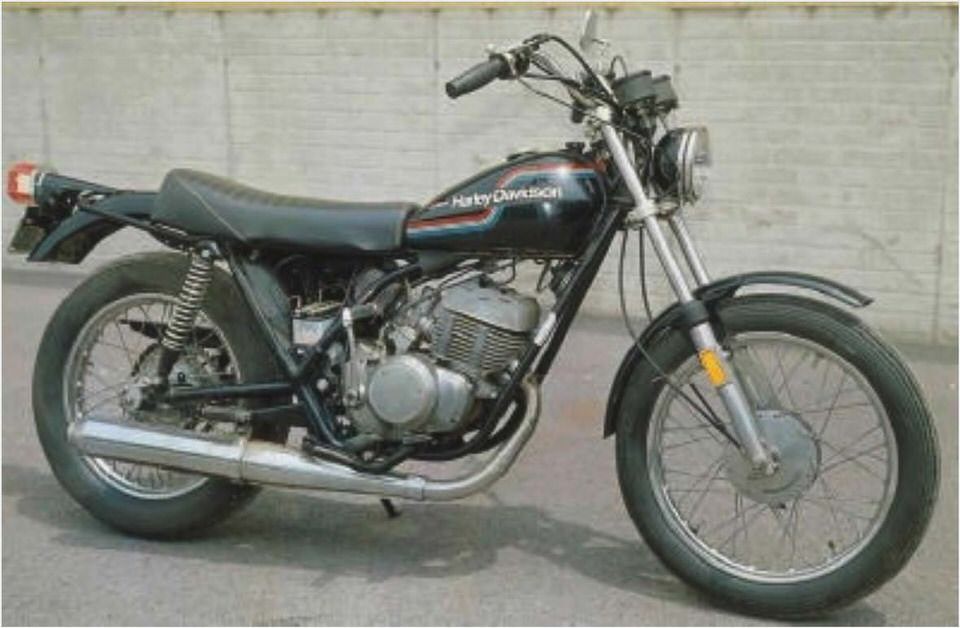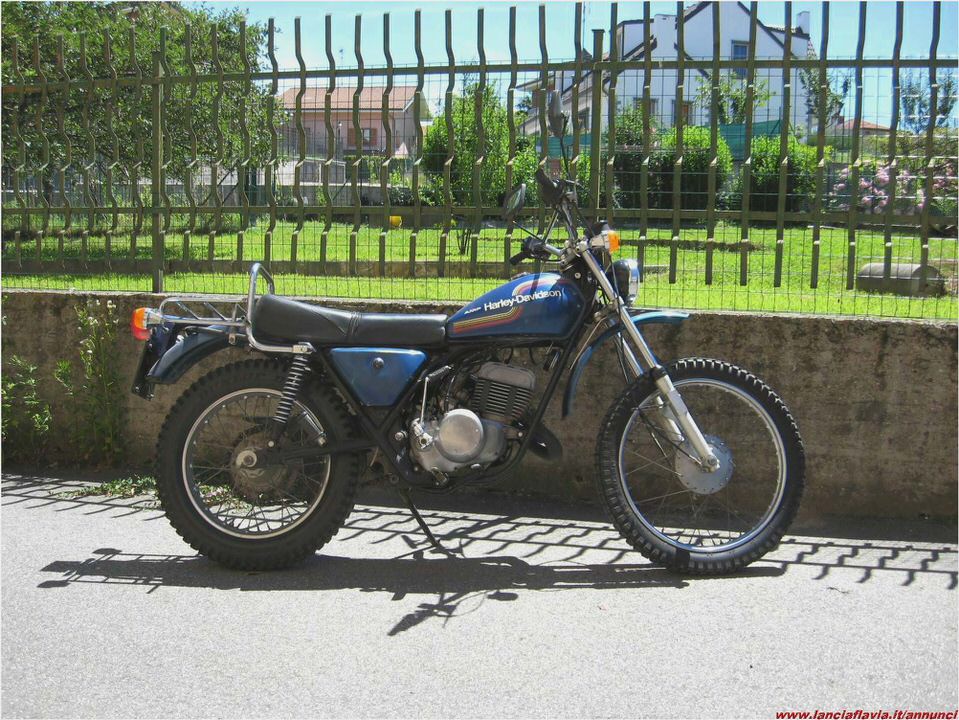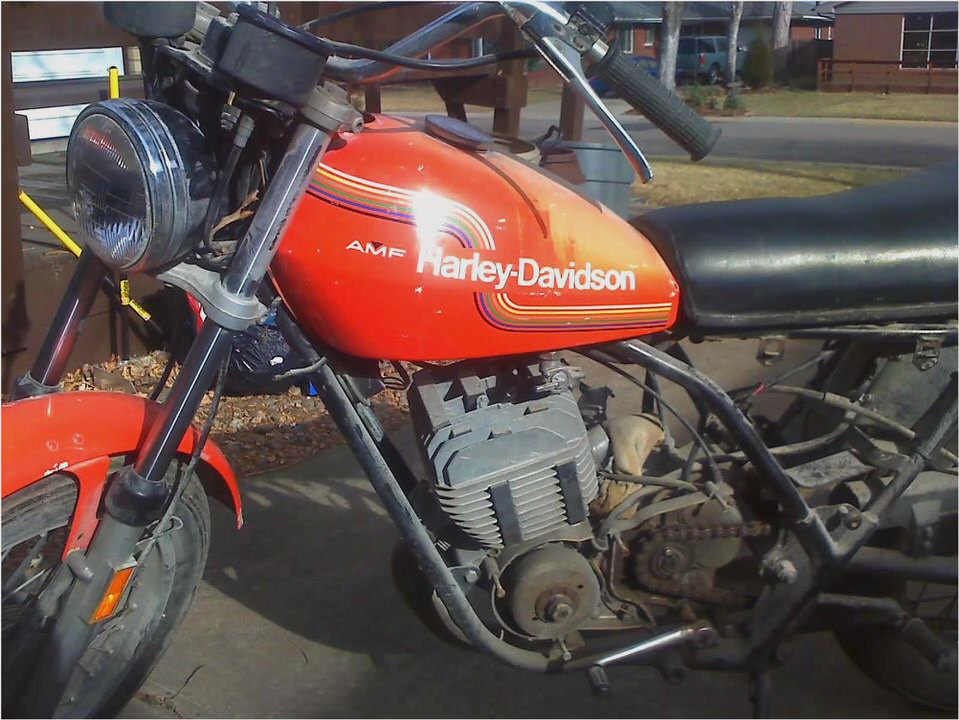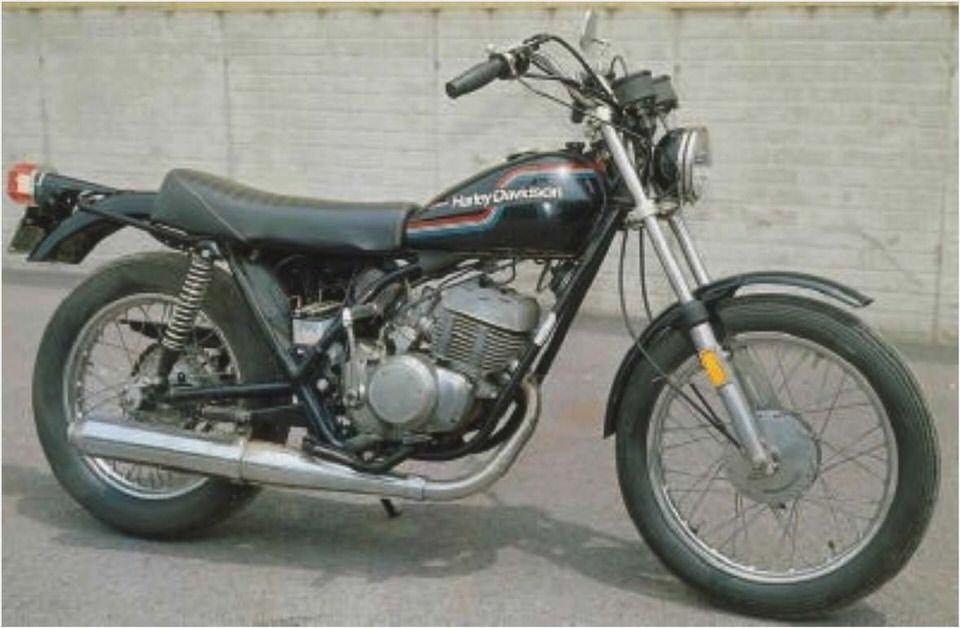

Related Content
Found on eBay: 1969 Honda CL350
Honda’s Scrambler-style motorcycles from the late 1960s and early 1970s are neat little bikes that s.
Found on eBay: 1962 Matchless G2CS
Winter is here and the first big snow has already fallen in many parts of the U.S. and while that m.
Trophy Winners at the 2011 Motorcycle Classics Road America Ride Show
Trophy winners at the 2011 Motorcycle Classics Road America Ride Show.
Found on eBay: 1974 Harley-Davidson Sportster 1000
Harley-Davidson Sprint SX350
Claimed power: 25hp @ 7,000rpm (1971)
Top speed: 90mph
Engine: 344cc air-cooled OHV horizontal single
Weight (dry): 312lb
Price then/now: $870 (1971)/$2,400-$4,500
It’s a simple and time-honored recipe. Take a street-standard motorcycle, fit trail-type tires, scrambles handlebars and a high-level exhaust system, and — hey, presto! — your road bike becomes a mud-plugging enduro or desert-dueler. Of course, most street scramblers weren’t true offroad machines — but they looked like them.
And the look was hot.
All this made sense to Harley-Davidson in 1971. Their 350SS street bike was hopelessly outclassed by Japanese twins of the same capacity, so to squeeze a few more years out of the ageing Aermacchi design they moved the 350 single into a bracket where standing quarter times and racetrack handling were less important.
The first generation SX350 really was little more than a 350SS street bike dressed up for the dirt. It retained the street bike’s banana-shaped spine frame with the engine slung below. For added strength, the rear subframe and suspension bolted to a pair of forged members replacing what had been tubes: stronger, maybe, but definitely heavier.
Eighteen-inch rear and 19-inch front wheels were fitted with seriously knobby offroad tires rolling under abbreviated, high-mounted fender blades. A smaller gas tank and shorter seat were fitted, and gone was the street bike’s tachometer, together with the dated binnacle it lived in. High, cross-braced handlebars and a high-level muffler with wire heat shield finished the street-to-dirt makeover.
Underneath, not a lot changed. The Harley-Davidson Sprint SX350 retained the drivetrain and major components from the SS, including the street bike’s long-stroke 74mm x 80mm pushrod 4-stroke single, which continued to drive a 4-speed transmission through a gear primary and dry multiplate clutch, with chain drive to the rear wheel. Shifting was on the right, as was the kickstand, and the kickstarter was on the left — something that took American riders some getting used to.
Cycle Guide started its April 1971 review on the SX350 by saying, “if there is a more rugged enduro-type motorcycle than the new Harley Davidson 350cc Sprint, we haven’t run across it.” But that ruggedness came at a cost in weight: At 312 pounds dry, Cycle Guide considered the SX to be “almost 100lbs heavier than its competition” with a full tank of gas. (Though they didn’t specify what that competition was, a same year Bultaco Sherpa 350 weighed a claimed 211 pounds.) They also found that if the SX was “left sitting idle several days at a time. it then became necessary to bump start it.” Not a sterling commendation.
But the biggest problem with the Harley-Davidson Sprint SX350, Cycle Guide said, was its basic configuration: With longer suspension than the street version, the engine’s crankshaft was now above the level of the wheel hubs, meaning the center of gravity was too high. That, they said, made the SX “difficult to handle in tight situations.” Overly stiff shocks didn’t help, although the editors liked the bike’s Ceriani forks, saying they were “soft and provide a comfortable ride.” And while standing on the pegs improved offroad handling, it then became almost impossible for the rider to operate the shift lever. But more seriously limiting the SX’s offroad pretensions was engine protection: There wasn’t any. “Even worse than that, the exhaust pipe hangs down beneath the motor,” Cycle Guide said, making it “no problem to destroy an exhaust pipe if you encounter an obstacle of any size at all.”
In 1972 Harley-Davidson (now under AMF control) bought the remaining 50 percent of Aermacchi it didn’t already own and invested a chunk of change to update the SX350 and 350SS. A new double cradle frame meant the SX’s engine and exhaust were offered some protection, while electrics went to 12 volt from 6, meaning an electric starter could also be added. And while the kickstarter was still on the left, it was joined by the shift lever and kickstand, both of which had previously been on the right.
All this effort was largely wasted, as only around 11,000 Harley-Davidson Sprints of all guises (street and enduro) were sold over 1973-1974. Japanese 2-stroke twins had way more performance for way less money. H-D seemed to agree, because they refocused the Italian subsidiary toward the 2-stroke race bike program, which rewarded them with three 250cc world championships in 1974-1976 and the 350cc title in 1976 with Walter Villa in the saddle.
The 350 was dropped for 1975, and the Castiglioni brothers bought the remains of Aermacchi motorcycles and the Varese factory in 1978.
Contenders: Street-enduro rivals to the Harley-Davidson Sprint SX350
Ducati 350 Scrambler
Claimed power: 24hp @ 8,500rpm
Top speed: 80mph top speed (est.)
Engine: 340cc air-cooled SOHC single, 5-speed
Weight: 293lb (dry)


Price then/now: $750 (est.)/$4,500-$6,500
The first new wide case Ducati singles introduced for 1968 were the 250cc and 350cc Scramblers. Just like the SX350 and Honda’s CL350, the 350 Scrambler was more about offroad show than go, with a 19-inch front wheel wearing a street tire and still sporting a low-level exhaust. Only the high and wide handlebars — and slender fenders — hinted at off-highway work.
Under the hood, though, was a thoroughbred Ducati bevel-drive (spring valve, not desmo) single overhead cam engine with a straight-cut gear driving a wet multiplate clutch and 5-speed transmission. A 27mm Dell’Orto carb supplied fuel, ignited by contact breaker and 6 volt coil. The power unit slotted into a conventional single downtube frame with 35mm Marzocchi front forks and three-way adjustable shocks controlling the swingarm rear.
Brakes were 8-inch front and 6-inch rear single-leading-shoe drums. A makeover for 1973 introduced a 29mm Dell’Orto carburetor, aluminum wheel rims, a double-sided front brake and electronic ignition.
Spring-valve, wide case singles may be the most reliable early Ducatis and the easiest to live with. Stronger than narrow case singles, the engines earned a reputation for bulletproof durability, and the relative simplicity of the spring-valve top end meant easier maintenance — though valves still required shim adjustment. The 350 was perhaps the better engine capacity, too, with more torque than the revvier 250, and using essentially the same cycle parts.
1968-1973 Honda CL350
Claimed power: 33hp @ 9,500rpm
Top Speed: 100mph top speed
Engine: 325cc air-cooled SOHC parallel twin, 5-speed
Weight: 346lb (wet)
Price then/now: $700/$1,500-$3,000
The new for 1968 CL350 Street Scrambler used an all-new 325cc air-cooled 4-stroke parallel twin. A chain drove a single overhead cam by a sprocket featuring bonded rubber dampers to reduce noise. Progressively wound valve springs reduced camshaft loads and valve seat pressure, while valve adjustment was as simple as loosening a locknut and rotating one of the four eccentric rocker shafts.
The 64mm diameter pistons ran in pressed-in iron liners in a light alloy cylinder block. Primary drive was by staggered-tooth, dual straight-cut gears to reduce noise and gear lash to a wet multiplate clutch and 5-speed constant-mesh gearbox, all fitted in a horizontally split, wet-sump crankcase. Keihin constant-velocity 26mm carbs delivered the fuel, with a new intermediate fuel/air circuit to provide more accurate fueling transitions.
Intake ports were designed to optimize gas velocities over a wide rev range, as were the small-diameter, double-wall header pipes. The result was 33 horsepower at 9,500rpm and plenty of torque across the rev range.
The frame was typical Honda, a sturdy pressed-steel top member and steel tube cradle with telescopic forks and dual shocks. Brakes were 8-inch twin-leading-shoe front and 6-inch single-leading-shoe rear. With its 2.4-gallon fuel tank full, the CL350 tipped the scales at 346 pounds and was good for 100mph.
Cycle magazine tested the first CL350 in May 1968, and found almost nothing to fault it on; they speculated the CB/CL350 could just be the best motorcycle ever built. MC

- Dyna Super Glide Custom Review Harley-Davidson® Sportster Forty-Eight®…
- Harley Davidson Cross Bones Hot Bike
- Harley sprint parts – Circuss Party
- 2009 Harley-Davidson CVO Fat Bob Review – Ultimate MotorCycling
- 2010 Harley-Davidson Electra Glide Ultra Limited FLHTK – Touring…

